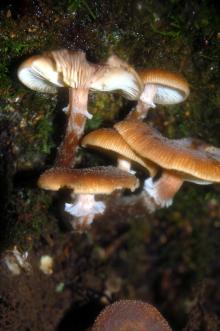By L. Sims
See:
Oak (Quercus spp.) - Armillaria Root Rot
Cause The fungus Armillaria nabsnona has been found associated with living and dead alders from the north coast of California through coastal Oregon, coastal Washington, and British Columbia. Infected trees are susceptible to being blown over especially on sites with flooding or steep slopes. Armillaria sp. infected trees were found inland in southern Oregon mostly on dead trees and with little on site canopy dieback.
Symptoms Infected trees may show canopy dieback and have root systems that are partially decayed. Wind thrown trees have root balls with partially decayed root systems and occur in pockets or areas. Black, shoestring-like structures, called rhizomorphs, occur on large diameter rotted roots. Numerous fruiting bodies arise from the root collar area of a diseased tree or cut stumps. Mushrooms are honey-colored or light tan, with a stalk 4 to 6 inches or more in height and a cap 2 to 4 inches across, often dotted with brown scales.
Cultural control In coastal areas avoid planting on steep banks and in areas subject to flooding to discourage development of hazard trees.
References Morrison, D.J. 2004. Rhizomorph growth habit, saprophytic ability and virulence of 15 Armillaria species. Forest Pathology 34:15-26.
Volk, T.J., Burdsall Jr., H.H., and Banik, M.T. 1996. Armillaria nabsnona, a new species from western North America. Mycologia 88: 484-491.



